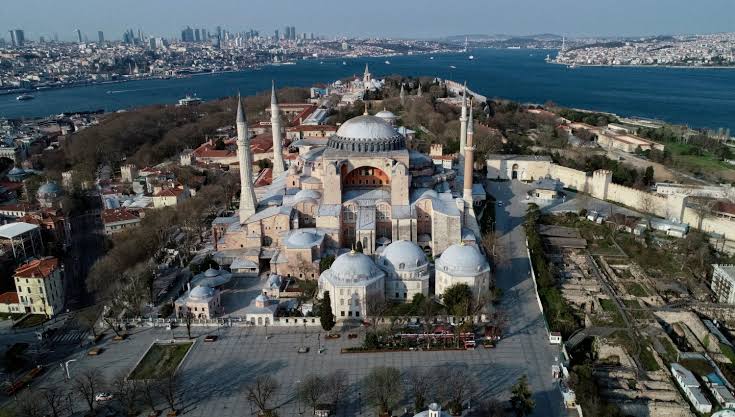Atatürk and Erdoğan: The Glory of Hagia Sophia By Abu Mazeedatilkhayr Bn Sa’eed
It’s now 80 years that the founder of the Turkish republic, Mustafa Kemal Ataturk, had died….
It’s now 80 years that the founder of the Turkish republic, Mustafa Kemal Ataturk, had died. As he aged and shortly before he breathed his last, he said to the people of Turkey, “Remember me”. The Turks have since obliged, and thus till date, his face still stares sternly down on nearly every town square, schoolyard and workplace in the country.
His successors to the republican throne have carved for him an infallible image of the driving ruler who built the republic on the post-World War I ruins of the Ottoman Empire. It’s indeed a beauty to behold seeing Turkish museums keep special places for Ataturk’s finely tailored clothes and even his carefully creased pajamas. I saw this myself!
At the Istanbul Airport named after him, the first thing you see is the pictorial image of Ataturk. His immortal presence appeared in different angles of the republic. His secularist westocratic mentality is also reflective in the thought system of many Turks. The religious value, hitherto celebrated in the Ottoman era, was then relegated by the Kamelists.
In 1923, when Ataturk demolished the last piece of Khilaafah, it wasn’t any pleasant for the entire Muslim world. The whole of Turkey was itself completely culturized in strange ideas antithetical to Islamic values. The wearing of turban was banned. The use of hijab and even scarf became a criminal offence. Arabic letters and alphabet were also proscribed by Ataturk.
The Adhan call to prayer was publicly declared a harmful noise. Thus, Islam became so strange in a territory once ruled by a chain of 36 Ottoman Sultans who had succeeded one another with the crescent flag of caliphacy. It was the hero, Osman I , a leader of the Turkish tribes in Anatolia, who founded the Ottoman Empire around 1299.
A formal government was set up by Osman I and further expanded in the reigns of Orhan, Murad I and Bayezid I . But not until 1453 when Mehmed II , the conqueror, led the Ottoman Turks in siezing the ancient city of Constantinople that the 1,000 years of Byzantine’s reign came to an end. Sultan Mehmed then renamed the city Istanbul and made it the capital of the Ottoman Empire.
By 1517, Bayezid’s son, Selim I, had brought Syria, Palestine, Egypt, Jordan, Lebanon, the two territories of Haramain and other parts of the Arab world under the Ottoman control. Thus, the Empire had reached its peak between 1520 and 1566, during the reign of Sultan Suleiman, the Magnificent. Indeed, this period was marked by great power, affluence, influence, stability and wealth for the Muslim world.
Suleiman, the magnificent, created a uniform system of law in the whole of the Muslim world and welcomed different forms of legitimate arts and literature. Throughout his reign, the empire expanded and included many areas of Eastern Europe. How would you feel today getting to know that European countries, such Romania, Greece, Macedonia, Bulgaria, Hungary and some other parts of the West were, until recently, under the Muslim rule.
Throughout the glorious era of our history, the Muslim world was indeed the “envy” of all. With the Sultan in Istanbul, we flourished proudly under a single leader. History is a witness to the achievements of that period. However, Mustafa Kamal Ataturk suddenly emerged with a revolutionary tendency and dethroned the caliphate, while enthroning his westocratic secular ideas in the Muslim enclave.
Until recently, the late Ataturk remained the hero of the modern day Turkey. His Godless ideas ruled the state. But although he is lauded as “immortal” in the 1982 constitution of the republic, time has ceased to stand still for his name in the recent time. The most recent attempt at bringing back the republic to Islam was however in mid 1990s by Professor Nicmetin Erbakan whose Welfare Party had gloriously won at the poll.
The Welfare Party’s manifesto was primarily aimed at Islamic reform. But unfortunately, a coup occurred in 1997 against the short-lived Islamist government. It was what the Turks had called “a coup by letter.” The leadership of the Turkish military only delivered a memorandum, which initiated a process that led to the resignation of the Islamist Prime Minister, Necmettin Erbakan, and caused the dissolution of his coalition government.
Thus, after the 1997 military coup, the swiftly fell into secularism. The late 1990s famously saw the persecution of women wearing headscarves in public places, a ban that had been originally implemented but loosely enforced by Atatürk in an effort to firmly establish a secular nation. After 1997, the Islamists became alienated, at least for a certain period.
But then, their Welfare Party, which had been dissolved by the coupists, was later reborn as the Virtues Party, and with it was also born a new breed of Islamic activists who stood for religious freedom and against the excesses of secularism. One of the leaders of this pious breed was the one time mayor of Istanbul, Recep Tayyip Erdoğan, the man whose life would later rewrite the contemporary global history of Islam.
Erdoğan’s ascendancy in Turkish political life was swift, indeed. In 2003, he was elected Prime Minister, coming to power as part of a backlash against secularism’s impingement on religious freedoms. He had long been unpopular among cosmopolitan and non-religious Turks, but he had always enjoyed staunch support among the rural and religiously conservative. He then leveraged on the masses’ thirst for religious awakening that was long lost, to win at the poll.
Throughout his tenure as Prime Minister and now as President, Erdoğan has championed the cause of Islamic reform in Turkey. He distanced himself from Atatürk and his legacy of disbelief. Today, on the global stage, he is viewed as the father of a new Turkish identity, one aligned more closely with its Ottoman past – the Islamic heritage. He has certainly taken the country in a more religious direction, similar to where it was prior to the coup of 1997.
He had started by gladly enthroning himself in the hearts of the Turkish people by, first, repairing the battered economy of the nation. He then created an unprecedented achievement for the country, which no leader in the past history of the republican state, not even in the entire Muslim world, and of course, not also in the world at large, has ever achieved. It was a story of pride for the Muslim Turks.
Erdoğan successfully made a rail – a long-lost link between Europe and Asia underneath the sea. The world’s deepest underwater railway tunnel was opened under the Bosphorus, connecting two continents by rail for the first time. In that project, almost a mile of the 8.5-mile (13.6km) tunnel between the European and Asian sides of Turkey’s largest city is immersed under 56 metres (184ft) of water.
When the President was asked by the press on what had inspired this unprecedented project, he responded proudly that it was not a new idea, that searching through the archives of the Ottoman Empire, he came across a dream design of a project by the Ottoman sultan, Abdülmejid, in 1860, of a railway tunnel under the Bosphorus straits, one of the world’s busiest shipping lanes.
Today, the Turkish military is gradually Islamised. The use of head scarf, veils and hijab has been legalized. The Islamic heritage is back on its feet in the Turkish territory. The historic legacy of Imam Khatib madrasah, wherein the youths, youngsters and adolescents, learn the Quran, but which was hitherto abolished by Ataturk in 1924, has just been restored by Erdoğan. The Islamic fervour is now rekindled in the Turkish populace.
The most recent of the reformist achievements in Islamic awakening is the ultimate restoration of the glory of Hagia Sophia. Known as Ayasofya in Turkish language, it is a domed monument built as the cathedral church of Constantinople between 532 and 537 on the orders of the Roman Emperor, Justinian I. The basilica is said to have been designed by the Greek geometers Isidore of Miletus and Anthemius of Tralles.
This monument remained the world’s largest cathedral for nearly a thousand years, until Seville Cathedral was completed in 1520. In 1204, it was converted by the Fourth Crusaders to a Roman Catholic cathedral under the Latin Empire, before it was restored to the Eastern Orthodox Church upon the return of the Byzantine Empire in 1261.
After the Fall of Constantinople to the Ottoman Empire in 1453, it was then converted to a mosque. But in 1935, when the infamous revolution of the historic vandal, Mustafa Kamal Ataturk, started demolishing the caliphate, the mosque fell a victim to his hatred for Islam and its heritage. it was then secularized into a museum by the Kamelist regime.
However, in early July 2020, just this week, 86 years after, the Turkish Council of State annulled the Kamelist Cabinet’s decision of 1934 to establish the museum, revoking the monument’s status and a subsequent decree of the President of Turkey ordered the re-classification of Hagia Sophia as a mosque. Yesterday, we all listened to the call of Adhan at the mosque. Oh, Erdoğan, you’ll die not early!
Let’s pray for Erdoğan, he’s our pride!


